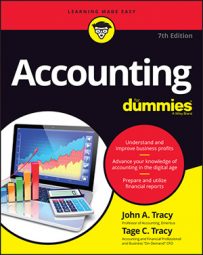If you read financial information on websites, such as Yahoo! Finance, for instance, keep in mind that the information comes from the financial reports prepared and issued by the business.
Starting with the financial statements
Here are the fundamentals of the three primary financial statements of a business:- Income statement: The income statement summarizes sales revenue and other income (if any) and expenses and losses (if any) for the period. It ends with the bottom-line profit for the period, which most commonly is called net income or net earnings. (Inside a business, a profit performance statement is commonly called the profit and loss, or P&L, report.)
- Balance sheet: The balance sheet summarizes the financial condition, consisting of amounts of assets, liabilities, and owners’ equity at the closing date of the income statement period (and at other times as needed by managers). Its formal name is the statement of financial condition or statement of financial position.
- Statement of cash flows: The statement of cash flows reports the net cash increase or decrease during the period from the profit-making activities reported in the income statement and the reasons this key figure is different from bottom-line net income for the period. It also summarizes sources and uses of cash during the period from investing and financing activities.
The three primary statements, plus footnotes to the financials and other content, are packaged in an annual financial report that is distributed to the company’s investors and lenders so they can keep tabs on the business’s financial health and performance. Abbreviated versions of their annual reports are distributed quarterly by public companies, as required by federal securities laws. Private companies do not have to provide interim financial reports, though many do.
Keeping in mind the reasons for financial reports
A financial report is designed to answer certain basic financial questions:- Is the business making a profit or suffering a loss, and how much?
- How do assets stack up against liabilities?
- Where did the business get its capital, and is it making good use of the money?
- What is the cash flow from the profit or loss for the period?
- Did the business reinvest all its profit or distribute some of the profit to owners?
- Does the business have enough capital for future growth?
People should read a financial report like a road map: to point the way and check how the trip is going. Managing and putting money in a business is a financial journey. A manager is like the driver and must pay attention to all the road signs; investors and lenders are like the passengers who watch the same road signs. Some of the most important road signs are the ratios between sales revenue and expenses and their related assets and liabilities in the balance sheet.
In short, the purpose of financial reporting is to deliver important information that the lenders and owners of the business need and are entitled to receive. Financial reporting is part of the essential contract between a business and its lenders and investors. Although lawyers may not like this, the contract can be stated in a few words:Give us your money, and we’ll give you the information you need to know regarding how we’re doing with your money.
Financial reporting is governed by statutory and common law, and it should abide by ethical standards. Unfortunately, financial reporting sometimes falls short of both legal and ethical standards.
Businesses assume that the readers of the financial statements and other information in their financial reports are knowledgeable about business and finance in general and understand basic accounting terminology and measurement methods. Financial reporting practices, in other words, take a lot for granted about readers of financial reports. Don’t expect to find friendly hand-holding and helpful explanations in financial reports. Reading financial reports is not for the faint of heart. You need to sit down with a cup of coffee (or something stronger) and be ready for serious concentration.

